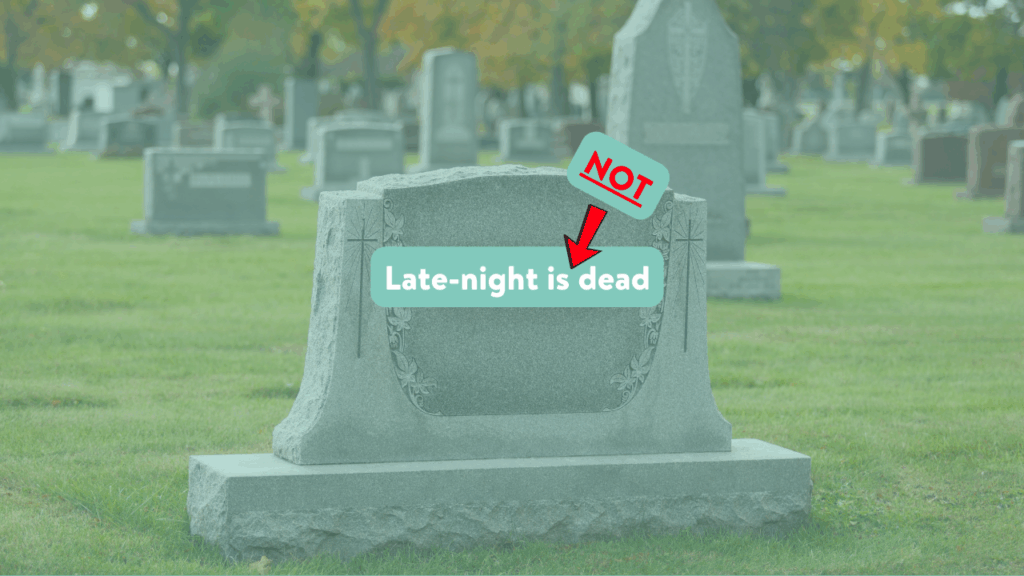Late-night is not dead

Every few months, some trade headline or Very Serious TV Columnist™️ tries to bury late-night. “End of an era! End of all eras!” “TV is over! Finished!” “What is a desk? And how do we find one?” But, luckily for us (and unfortunately all men named Jimmy), late-night can’t stay “dead.” It’s unkillable. The second Colbert cracks a monologue joke about Mitch McConnell or Meyers drops another Closer Look, the genre rises from the ashes. Nevertheless, late-night persists. Stronger, snarkier, and soon, we hope, wearing better suits.
This seemingly endless invincibility makes the recent (and shocking) cancellation of The Late Show with Stephen Colbert feel especially surreal. This was the #1 show in the format! “The Late Show franchise may have come to an end faster than we could have expected, but I have no fear that Colbert’s loyal fan base will follow him wherever he decides to go,” says Andie Braithwaite, a member of the Late Show team (and a GOLDie!). She adds: “Season 11 is about to be big.” Don’t count him (or the genre) out just yet.
Because here’s the truth: late night isn’t disappearing—it’s shapeshifting. “Late night isn’t dead. It’s evolving,” says Nick Pappas, Disney+ (and GOLD late-night instructor). “Streamers are giving late-night a new shape, whether that’s shorter segments, niche voices, or shows that live beyond a time slot.”
And so far, we’ve seen only the tiniest sliver of what streaming can do with the form. Everybody’s in L.A. (which spun into Everybody’s Live on Netflix) with John Mulaney is buzzy, chaotic, deeply weird, and … duh, successful. It proved there’s an appetite for the late-night vibe without the 11:30pm time slot. The fact that more streamers haven’t jumped in yet? Kind of shocking. But it’s coming. You can feel it.
The DNA of late night has already spread into the larger culture. Desk games, goofy interviews, prank calls—stuff that used to belong to Letterman or Fallon or Corden—now lives as content marketing for big-name publications. Vogue’s lie detector test? That’s a late-night bit! Teen Vogue’s prank call series? Same. Even BuzzFeed’s puppy and kitten interviews are basically what Carson used to do with the animal wranglers…just, like, way cuter and optimized for TikTok. Late-night hasn’t vanished; it’s been atomized into everything.
Hope Rehak, who literally teaches a class called History of Late Night at Northwestern, puts it even more bluntly: “I don’t think late night is dead so much as (a) being strangled and (b) not keeping up with the changing times.” She points out that networks are still, bafflingly, betting on “older white men” instead of developing “younger, nonwhite, not-male talent.”
The format isn’t the problem (and neither is the time slot, really! Just ask everyone’s suburban parents who sent “Jimmy’s back!” to the family group message during Kimmel’s premiere last week). The problem is who’s allowed to hold the mic and wear the suit. And that’s definitely not a new problem for the genre!
And if you’re worried that TikTokers are going to “replace” Jimmy, Seth, and Stephen—don’t. Mark Kramer of NBC’s Late Night Writers Workshop (and another GOLD late night instructor!) has a more realistic take: “Even if you believe that the current format will be replaced by huge YouTubers, studios will eventually pay these creators big (money) to make shows for them, and those shows will need capable union writers to make these creators look good to a broader audience.”
In other words: late-night is still going to need late-night people. Late-night is still going to need YOU. (Let’s all just hold hands and pray that it’s not for The Tonight Show with Mr. Beast.)
The genre’s not dead. Rejoice! (Briefly, and then, like, come on, let’s get to work.) Late-night is just figuring out its next costume change. Maybe the future is Colbert on streaming. Maybe it’s a Gen Z host who grew up on Hot Ones. Or maybe Chicken Shop Date will finally get HBO money. No matter what, the thing late-night has always been best at—holding up a foggy funhouse mirror to the culture—is still something we can’t live without.




